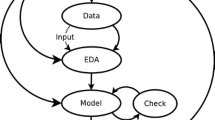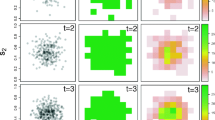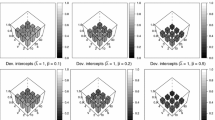Abstract
A community is “nested” when species assemblages in less rich sites form nonrandom subsets of those at richer sites. Conventional null models used to test for statistically nonrandom nestedness are under- or over-restrictive because they do not sufficiently isolate ecological processes of interest, which hinders ecological inference. We propose a class of null models that are ecologically explicit and interpretable. Expected values of species richness and incidence, rather than observed values, are used to create random presence–absence matrices for hypothesis testing. In our examples, based on six datasets, expected values were derived either by using an individually based random placement model or by fitting empirical models to richness data as a function of environmental covariates. We describe an algorithm for constructing unbiased null matrices, which permitted valid testing of our null models. Our approach avoids the problem of building too much structure into the null model, and enabled us to explicitly test whether observed communities were more nested than would be expected for a system structured solely by species–abundance and species–area or similar relationships. We argue that this test or similar tests are better determinants of whether a system is truly nested; a nested system should contain unique pattern not already predicted by more fundamental ecological principles such as species–area relationships. Most species assemblages we studied were not nested under these null models. Our results suggest that nestedness, beyond that which is explained by passive sampling processes, may not be as widespread as currently believed. These findings may help to improve the utility of nestedness as an ecological concept and conservation tool.





Similar content being viewed by others
References
Andrén H (1994) Can one use nested subset pattern to reject the random sample hypothesis? Examples from boreal forest communities. Oikos 70:489–491
Atmar W, Patterson BD (1993) The measure of order and disorder in the distribution of species in fragmented habitat. Oecologia 96:373–382
Atmar W, Patterson BD (1995) The nestedness temperature calculator: a visual basic program, including 294 presence–absence matrices. AICS Research, Inc., University Park, NM, and the Field Museum, Chicago, IL. Accessed February 21, 2007. http://www.aics-research.com/nestedness/tempcalc.html)
Azeria ET (2004) Terrestrial bird community patterns on the coralline islands of the Dahlak archipelago, Red Sea, Eritrea. Global Ecol Biogeogr 13:177–187
Bascompte J, Jordano PJ, Melian CJ, Olesen JM (2003) The nested assembly of plant–animal mutualistic networks. Proc Natl Acad Sci USA 100:9383–9387
Berglund H, Jonsson BG (2003) Nested plant and fungal communities; the importance of area and habitat quality in maximizing species capture in boreal old-growth forests. Biol Conserv 112:319–328
Bird BM, Boecklen WJ (1998) Nestedness and migratory status of avian assemblages in North America and Europe. Biodivers Conserv 7:1325–1331
Boecklen WJ (1997) Nestedness, biogeographic theory, and the design of nature reserves. Oecologia 112:123–142
Bolger DT, Alberts AC, Soulé ME (1991) Occurrence patterns of bird species in habitat fragments: sampling, extinction, and nested species subsets. Am Nat 137:155–166
Bouliner T, Nichols JD, Sauer JR, Hines JE, Pollock KH (1998) Estimating species richness: the importance of heterogeneity in species detectability. Ecology 79:1018–1028
Brown JH (1978) The theory of insular biogeography and the distribution of boreal birds and mammals. Great Basin Nat Memoirs 2:209–227
Brown JH (1986) Two decades of interaction between the MacArthur–Wilson model and the complexities of mammalian distributions. Biol J Linnean Soc 28:231–251
Brualdi RA, Sanderson JG (1999) Nested species subsets, gaps, and discrepancy. Oecologia 119:256–264
Cam E, Nichols JD, Hines JE, Sauer JR (2000) Inferences about nested subsets structure when not all species are detected. Oikos 91:428–434
Coleman BD, Mares MA, Willig MR, Hsieh Y-H (1982) Randomness, area, and species richness. Ecology 63:1121–1133
Cook RR, Angermeier PL, Finn DS, Poff NL, Krueger KL (2004) Geographic variation in patterns of nestedness among local stream fish assemblages in Virginia. Oecologia 140:639–649
Cook RR, Quinn JF (1998) An evaluation of randomization models for nested species subsets analysis. Oecologia 113:584–592
Connor EF, Simberloff D (1979) The assembly of species communities: chance or competition? Ecology 60:1132–1140
Cutler AH (1994) Nested biotas and biological conservation: metrics, mechanisms, and meaning of nestedness. Landsc Urban Plann 28:73–82
Diamond JM (1975) Assembly of species communities. In: Cody ML, Diamond JM (eds) Ecology and evolution of communities. Harvard University Press, Cambridge, MA, pp 342–444
Diamond JM, Gilpin ME (1982) Examination of the “null” model of Connor and Simberloff for species co-occurrences on islands. Oecologia 52:64–74
Feeley K (2003) Analysis of avian communities in Lake Guri, Venezuela, using multiple assembly rule models. Oecologia 137:104–113
Fernández-Juricic E (2000) Bird community composition patterns in urban parks of Madrid: the role of age, size and isolation. Ecol Res 15:373–383
Ficetola GF, De Bernardi F (2004) Amphibians in a human-dominated landscape: the community structure is related to habitat features and isolation. Biol Conserv 119:219–230
Fischer J, Lindenmayer DB (2002) Treating the nestedness temperature calculator as a “black box” can lead to false conclusions. Oikos 99:193–199
Fischer J, Lindenmayer DB (2005) Perfectly nested or significantly nested—an important difference for conservation management. Oikos 109:485–494
Fleishman E, RacNally R (2002) Topographic determinants of faunal nestedness in Great Basin butterfly assemblages: applications to conservation planning. Conserv Biol 16:422–429
Johnson NK (1975) Controls of number of bird species on montane islands in the Great Basin. Evolution 29:545–567
Martín HG (2006) On the origin and robustness of power-law species–area relationships in ecology. Proc Natl Acad Sci 103:10310–10315
Gotelli NJ (2000) Null model analysis of species co-occurrence patterns. Ecology 81:2606–2621
Gotelli NJ, Entsminger GL (2001) Swap and fill algorithms in null model analysis: rethinking the knight’s tour. Oecologia 129:281–291
Gotelli NJ, Entsminger GL (2004) EcoSim: Null models software for ecology. Version 7. Acquired Intelligence Inc. and Kesey-Bear, Jericho, VT. Accessed February 21, 2007. http://www.garyentsminger.com/ecosim/index.htm
Gotelli NJ, Graves GR (1996) Null models in ecology. Smithsonian Institution Press, Washington, DC
Gotelli NJ, McCabe DJ (2002) Species co-occurrence: a meta-analysis of J. M. Diamond’s assembly rules model. Ecology 83:2091–2096
Grayson DK, Livingston SD (1993) Missing mammals on Great Basin mountains: holocene extinctions and inadequate knowledge. Conserv Biol 7:527–532
Higgins CL, Willig MR, Strauss RE (2006) The role of stochastic processes in nested patterns of species distributions. Oikos 114:159–167
Jonsson BG (2001) A null model for randomization tests of nestedness in species assemblages. Oecologia 127:309–313
MacArthur RH, Wilson EO (1967) The theory of island biogeography. Princeton University Press, Princeton, NJ
Manly BFJ (1995) A note on the analysis of species co-occurrences. Ecology 76:1109–1115
Maron M, MacNally R, Watson DW, Lill A (2004) Can the biotic nestedness matrix be used predictively? Oikos 106:433–444
Martínez-Morales MA (2005) Nested species assemblages as a tool to detect sensitivity to forest fragmentation: the case of cloud forest birds. Oikos 108:634–642
McAbendroth L, Foggo A, Rundle SD, Bilton DT (2005) Unravelling nestedness and spatial pattern in pond assemblages. J Anim Ecol 74:41–49
Miklós I, Podani J (2004) Randomization of presence–absence matrices: comments and new algorithms. Ecology 85:86–92
Moore JE, Swihart RK (2005) Modeling patch occupancy by forest rodents: incorporating detectability and spatial autocorrelation with hierarchically structured data. J Wildl Manage 69:933–949
Newmark WD (1991) Tropical forest fragmentation and the local extinction of understory birds in the eastern Usambara Mountains, Tanzania. Conserv Biol 5:67–78
Patterson BD (1987) The principle of nested subsets and its implications for biological conservation. Conserv Biol 1:323–334
Patterson BD, Atmar W (1986) Nested subsets and the structure of insular mammalian faunas and archipelagos. Biol J Linnean Soc 28:65–82
Quinn JF, Harrison SP (1988) Effects of habitat fragmentation and isolation on species richness: evidence from biogeographic patterns. Oecologia 75:132–140
Rizkalla CE, Swihart RK (2006) Community structure and differential responses of aquatic turtles to agriculturally induced habitat fragmentation. Landsc Ecol 21:1361–1375
Rodríguez-Gironés MA, Santamaría L (2006) A new algorithm to calculate the nestedness temperature of presence–absence matrices. J Biogeogr 33:924–935
Rosenzweig ML (1995) Species diversity in space and time. Cambridge University, New York
Sanderson JG, Moulton MP, Selfridge RG (1998) Null matrices and the analysis of species co-occurrences. Oecologia 116:275–283
Simberloff D, Martin J-L (1991) Nestedness of insular avifaunas: simple summary statistics masking complex species patterns. Ornis Fennica 68:178–192
Skaggs RW, Boecklen WJ (1996) Extinctions of montane mammals reconsidered: putting a global-warming scenario on ice. Biodivers Conserv 5:759–778
Stone L, Roberts A (1990) The checkerboard score and species distributions. Oecologia 85:74–79
Swihart RK, Moore JE (2004) Conserving biodiversity in agricultural landscapes. Purdue University Press, West Lafayette, IN
Wethered R, Lawes MJ (2005) Nestedness of bird assemblages in fragmented Afromontane forest: the effect of plantation forestry in the matrix. Biol Conserv 123:125–137
Worthen WB (1996) Community composition and nested-subset analyses: basic descriptors for community ecology. Oikos 76:417–426
Wright DH, Patterson BD, Mikkelson GM, Cutler A, Atmar W (1998) A comparative analysis of nested subset patterns of species composition. Oecologia 113:1–20
Wright DH, Reeves JH (1992) On the meaning and measurement of nestedness of species assemblages. Oecologia 92:416–428
Acknowledgments
We thank C. Rizkalla, J. Duchamp, N. Lichti, J. Goheen, P. Waser, N. Sanders, and two anonymous reviewers, for their useful comments on early manuscript drafts. Thanks to M. Rodríguez-Gironés for providing a version of BINMATMEST that allowed us to batch process large numbers of random matrices. We thank hundreds of Indiana private landowners for granting us access to their properties to collect field data. L. Connolly, G. Fontaine, T. Gross, A. Houston, C. Jacobs, N. Myatt, S. and S. Nienhuis, E. Oppelt, D. Packett, J. Panek, A. Reimer and R. Sutterer conducted many point counts. J. Crick, T. Preuss, L. Connolly, and N. Engbrecht coordinated field efforts and managed data. Financial support was provided by the Cooperative State Research, Education, and Extension Service, U.S. Department of Agriculture, under Agreement No. 2000-04649, and by the John S. Wright Fund, Department of Forestry and Natural Resources, Purdue University.
Author information
Authors and Affiliations
Corresponding author
Additional information
Communicated by Nathan Sanders.
Rights and permissions
About this article
Cite this article
Moore, J.E., Swihart, R.K. Toward ecologically explicit null models of nestedness. Oecologia 152, 763–777 (2007). https://doi.org/10.1007/s00442-007-0696-0
Received:
Accepted:
Published:
Issue Date:
DOI: https://doi.org/10.1007/s00442-007-0696-0




